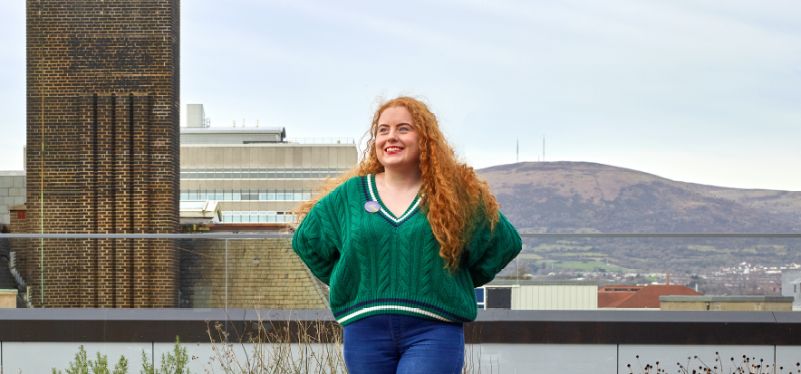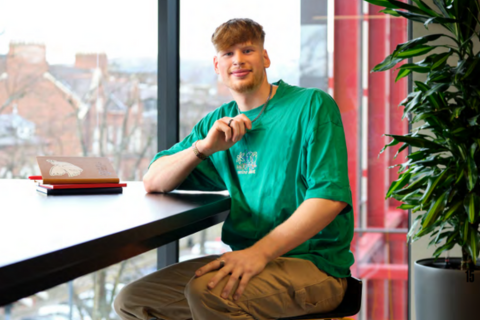Hope
We all need hope. Sometimes it's to be found in the most unlikely places.

“Walk on air against your better judgement,” said the poet Seamus Heaney (English, 1961), while accepting his 1995 Nobel Prize for Literature. And as a maxim for life, it’s hard to beat: it encourages an adventurous spirit, to aspire to what Heaney called the “marvellous”, and it urges us to look up and not down. In short, it calls on us to have hope.
And hope is the strongest human emotion, above fear, joy and even love, says acclaimed artist and author Oliver Jeffers, a previous Fellow of the Seamus Heaney Centre. “Hope separates us from other animals, as it requires imagination about an unwritten future. But where is our current trajectory going to take us? What future are we composing? Where do we begin?
Jeffers suggests that we are all just a collection of stories. “The most powerful tool at human disposal is our ability to change the stories we tell ourselves and each other. And now, it seems, more than ever, we need to change our collective story.
“One of the most obvious shifts we can make is in the stories we tell ourselves. To shift our motivation. I no longer ask people their desired outcomes when discussing world views, or current affairs. Instead, I ask them how they want to feel. Measuring how we want to feel might be a much healthier metric for a hopeful future.”
Asking people how they want to feel can have some surprising results. Take palliative and end-of-life care. It might seem like the last place you’d find hope. But for those facing terminal diagnoses, hope is a crucial ingredient, helping to set realistic expectations, keeping conversations going, adapting to new challenges – and helping people to look further into the future.
“To maximise quality of life, a person-centred approach is vital,” says Professor Joanne Reid, Chair of Cancer and Palliative Care at the School of Nursing and Midwifery. “What’s really important is that these things are individualised, as they can dynamically change over time. We need to keep having these conversations so that people are heard, seen and valued.”
Reid experienced a wholly unexpected phenomenon around hope while undertaking her PhD in cachexia, a complex and currently untreatable syndrome that causes wasting in people with chronic illness and affects about nine million people globally. The study didn’t offer any miracle treatments or promises: it simply asked people to share the impact that cachexia was having on them. “I found that taking part not only demonstrated altruism but also a strong hope that things could be improved for people affected by cachexia in the future. So just agreeing to be part of the study was a declaration of hope.”

Palliative care has sadly been all too familiar to those with cystic fibrosis (CF) and their families. It’s an inherited condition that causes sticky mucus to build up in the lungs and digestive system, leading to lung infections and problems with digesting food.
Before the 1950s, children with the condition rarely lived beyond the age of five. Now it’s estimated that half of people born with cystic fibrosis will live to at least 47 – and beyond. And that doesn’t account for the most recent advances in treatment, such as those pioneered by Professor Stuart Elborn who, alongside his world-class research into CF, is Acting Provost and Deputy Vice-Chancellor.
Elborn led studies of the first therapy to treat the underlying causes of CF, which was found to drastically improve and prolong the lives of around half of CF patients. But it wasn’t just the therapy that was helping patients: it was hope. “I learned this graphically in a series of trials that we did,” says Elborn. “All the hard, clinical measurements were great, and that was fantastic. But, actually, what the people getting these new treatments were telling me was: ‘This has changed my life. I’ve got hope again.’”
Now, Elborn’s patients were living their lives. They embarked on career changes. They started families – he recently met one patient who is now mother to twins. “The research we do is fundamentally attached to the hope that we can make things better,” says Elborn. “We hope there’s a better future. If we don’t have hope, it’s a pretty miserable situation to be in.” And we need to keep hope alive for as long as we live, Elborn points out, highlighting the fact that social care needs significant improvement. “The way we treat our older people in more developed societies reflects a lack of understanding and respect. Flourishing shouldn’t just be for teenagers and 20-year-olds.”
Decisions on social care are often made in the political sphere, and here, too, hope plays a big part – not always in a positive way. “Hope that is not matched with careful study, reflection and planning can simply lead to disappointment,” says political behaviour expert Professor John Garry from the School of History, Anthropology, Philosophy and Politics. “Crossing your fingers and ‘hoping for the best’ represents baseless optimism and will likely lead to unrealised potential.
“On the other hand, if a sense of hope is the result of rationally working out what your best option is, given the information at your disposal, and your careful understanding of the nature of the choice on offer, then this can be positive. Such hope would represent cautious, rational and grounded optimism.”
But how do you hold on to hope when it feels impossible? In 1984, Dr Gail McConnell’s father William was murdered by the IRA outside their Belfast home: her 2021 collection, The Sun Is Open, addresses his life and death. She stays positive, McConnell says, through quiet reflection: time that allows her to work through intensely difficult subjects and create art.
McConnell didn’t write a single poem for the first two and a half years of the pandemic, as she and her partner juggled full-time work with childcare, and she looked after her students. Staying hopeful while not producing is essential to future work, she believes. “Those periods are so vital and fertile in ways that you can never really understand. It’s easy to have hope when you have just won a prize for a book. But when you’re up to your eyes in Lego and student emails and you’re desperate to write a sonnet because you haven’t for so long – that’s when you have to hope.”
Giving students that space, she says, is why she loves her work at Queen’s. “What we’re giving our students is a chance to think and to write and to read and, ultimately, to have an altered perspective on the world that gives them a sense of hope. They have a sense of how they might bring about change, how they might make an impact in the world and how they might feel empowered.”
“In this hope of a newer and better future,” says Oliver Jeffers, “it is worth remembering that while the old stories may no longer be fit for purpose, if we can respectfully see and hear them, give them space, then perhaps we can get away from being right over wrong, and move towards being better over worse. As noted by John Steinbeck, ‘In spite of overwhelming evidence to the contrary, the trait of hope still controls the future.’”
Hope, then, remains the crucial difference between holding on or giving up and, as Reid puts it, “turning one’s face to the wall”. Hope is at hand even in the darkest circumstances. The trick, it seems, is to watch out for it – and hold on to it when it appears.